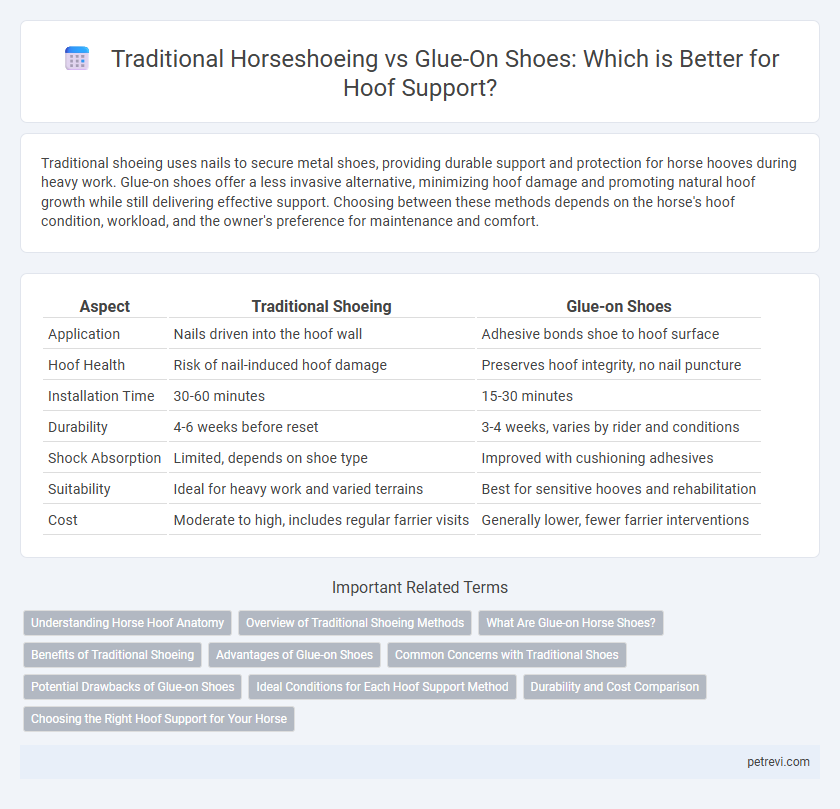Traditional shoeing uses nails to secure metal shoes, providing durable support and protection for horse hooves during heavy work. Glue-on shoes offer a less invasive alternative, minimizing hoof damage and promoting natural hoof growth while still delivering effective support. Choosing between these methods depends on the horse's hoof condition, workload, and the owner's preference for maintenance and comfort.
Table of Comparison
| Aspect | Traditional Shoeing | Glue-on Shoes |
|---|---|---|
| Application | Nails driven into the hoof wall | Adhesive bonds shoe to hoof surface |
| Hoof Health | Risk of nail-induced hoof damage | Preserves hoof integrity, no nail puncture |
| Installation Time | 30-60 minutes | 15-30 minutes |
| Durability | 4-6 weeks before reset | 3-4 weeks, varies by rider and conditions |
| Shock Absorption | Limited, depends on shoe type | Improved with cushioning adhesives |
| Suitability | Ideal for heavy work and varied terrains | Best for sensitive hooves and rehabilitation |
| Cost | Moderate to high, includes regular farrier visits | Generally lower, fewer farrier interventions |
Understanding Horse Hoof Anatomy
Understanding horse hoof anatomy is crucial for effective support, as the hoof consists of the sensitive laminae, sole, frog, and hoof wall, each requiring precise protection and weight distribution. Traditional shoeing involves nailing metal shoes to the hoof wall, providing durability but potentially risking hoof damage due to repeated nailing. Glue-on shoes offer a less invasive alternative by adhering directly to the hoof, preserving hoof integrity while accommodating sensitive or damaged areas, aligning with the anatomical needs for minimizing stress on the hoof's internal structures.
Overview of Traditional Shoeing Methods
Traditional shoeing methods involve nailing metal horseshoes directly onto a horse's hoof, providing durable protection and support during riding or work. Farriers shape the shoes to match the hoof's contour, ensuring proper balance and weight distribution to prevent strain or injury. This time-tested technique allows for easy customization and repeated adjustments, maintaining hoof health under various conditions.
What Are Glue-on Horse Shoes?
Glue-on horse shoes are specialized hoof supports attached using strong adhesives instead of nails, reducing damage to the hoof wall and offering a pain-free alternative for horses with sensitive or damaged hooves. They provide secure traction and protection during riding or therapeutic treatments, especially beneficial for horses with thin or brittle hooves where traditional shoeing poses risks. Advances in adhesive technology and shoe designs have improved durability and fit, making glue-on shoes a viable option for improving hoof health and performance.
Benefits of Traditional Shoeing
Traditional shoeing provides durable protection and optimal hoof support by securely nailing metal shoes onto the horse's hooves, which enhances traction and prevents excessive wear. This method allows farriers to customize shoe shape and size precisely according to the horse's hoof structure and specific needs, promoting balanced gait and biomechanical support. The reliability and longevity of traditional shoes make them ideal for performance horses engaged in rigorous activities such as jumping, racing, or trail riding.
Advantages of Glue-on Shoes
Glue-on shoes offer a less invasive alternative to traditional nailing methods, minimizing hoof wall damage and reducing the risk of injury or discomfort for horses. These shoes provide excellent traction and adaptability, making them ideal for horses with brittle or compromised hoof walls. The ease of application and removal also allows for more frequent adjustments, promoting better hoof health and performance.
Common Concerns with Traditional Shoes
Traditional shoeing often raises concerns about nail damage to the hoof wall, which can lead to cracking and splitting. The rigid metal shoes can restrict natural hoof expansion and contraction, potentially causing discomfort or impairing circulation. Additionally, frequent shoe replacements increase the risk of stress and injury to the hoof structure.
Potential Drawbacks of Glue-on Shoes
Glue-on shoes may lead to reduced hoof breathability, increasing the risk of thrush and other infections due to trapped moisture. There is also a higher likelihood of shoe detachment during intense activity or wet conditions, potentially compromising hoof protection. Some horses may experience allergic reactions to adhesive materials, causing irritation and discomfort.
Ideal Conditions for Each Hoof Support Method
Traditional shoeing is ideal for horses working on rugged terrain or carrying heavy loads, as nailed shoes provide durable protection and strong hoof support. Glue-on shoes suit horses with fragile hooves or sensitive skin, as they minimize hoof damage and offer a pain-free, flexible alternative. Selecting between methods depends on the horse's activity level, hoof condition, and environmental factors to ensure optimal support and comfort.
Durability and Cost Comparison
Traditional shoeing involves nailing metal shoes to the horse's hooves, offering proven durability and the ability to withstand tough terrains for several weeks, typically costing between $80 and $150 per shoeing session. Glue-on shoes provide a less invasive alternative, reducing hoof damage while lasting around 4 to 6 weeks, but they generally come with higher upfront expenses, often ranging from $150 to $200 due to specialized adhesives and labor. Cost-effectiveness varies by use; traditional shoes are preferred for long-term durability and frequent workloads, whereas glue-on shoes suit horses with sensitive hooves or those requiring short-term protection.
Choosing the Right Hoof Support for Your Horse
Choosing the right hoof support for your horse depends on factors such as hoof condition, workload, and environment. Traditional shoeing provides strong durability and protection, especially for horses engaged in heavy riding or rough terrain. Glue-on shoes offer a less invasive alternative, promoting hoof health and reducing nail-related damage, ideal for horses with compromised hooves or sensitive skin.
Traditional Shoeing vs Glue-on Shoes for Horse Hoof Support Infographic

 petrevi.com
petrevi.com